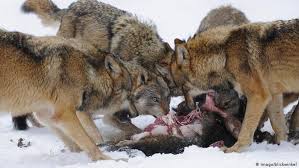Italian farmers wage war on protected grey wolves

Rome: In April last year, near the medieval village of Pitigliano in Tuscany, a wolf was skinned and suspended from a road sign.
The following October, another two wolves were hung in a similarly grisly display in Radicofani, south of Siena.
In July, in the French Pyrenees, hundreds of men from Pau set off on an illegal wolf hunt, brandishing rifles. They failed to locate an animal.
It was in this atmosphere that two northern Italian councils — Bolzano and Trento — introduced bylaws designed to permit locals to kill off so-called problem wolves.
Two men wearing Italian police uniforms squat down next to the body of a mutilated wolf, in front of a police car.
Last year, he had almost 10 per cent of his flock of 500 sheep taken by wolves as they grazed on pastures high above the hamlets of the Ultental Valley.
“Last year, the wolves were here and killed about 45 sheep, [they were] mauled to death, and we found them all over the place,” Mr Holzner said.
It was “a horrible sight”.
He says a century ago his forebears in Italy’s Tyrolean alps celebrated the death of the last wolf believed to have been roaming their mountains.
“No-one missed them,” he said. “And now they’re back.”
The council rules were passed after lobbying by agricultural groups to remove protections for the animal.
Oswald Schwarz from one such group, the Sudtiroler Bauernbund, was among those pressing for change, insisting “killing them is the only option we have”.
An aerial view of the Ultental Valley in Italy’s Tyrolean alps. The mountains and valley are green and lush.
Although the Government compensates farmers whose sheep are killed, Mr Schwarz insisted “the presence of wolves and bears is not compatible with our pasture farming”.
In the alps, custom dictates that the sheep be allowed to graze freely on their own, steadily climbing the mountains in search of fresh meadows.
The presence of wolves means “we’re unable to protect our animals”, Mr Schwarz said.
Claiming the compensation can be difficult as a carcass is required as evidence, and often the sheep simply disappear.
Europe’s wolves were hunted almost to extinction by the early 20th century.
In Italy, bands of trained wolf-hunters named Lupari traversed the flanks of the Tyrolean alps exterminating every wolf they could.
France’s mountainous regions were rid of wolves through similar policies dating back to the Middle Ages, including the establishment of the Grand Wolfcatcher, a prestigious appointment in the King’s royal household.
In the mid 20th century, however, protections for the animal were steadily introduced.
In Italy the government passed federal protections in July 1971; an international treaty on animal conservation, the Bern Convention, was adopted in 1979.
Since then wolf numbers have steadily climbed. Estimates are contested, but there could be as many as 2,000 wolves now in Italy.
Carla Rocchi, director of ENPA, Italy’s national animal protection society, said the rogue killing of wolves and displaying their carcasses in public was a move designed to send a message.
“‘If we are not allowed to shoot wolves, we will kill wolves in other horrible ways’, this is the meaning,” she said.
The council bylaws have been held up by a central government appeal, lodged in September, to Rome’s top constitutional court, which claims the two semi-autonomous regions have overstepped their powers.
It is expected that a final resolution to the question will not surface until sometime next year.
Whatever the outcome, Mr Schwarz said the wolf would never be welcome in the north of the country





